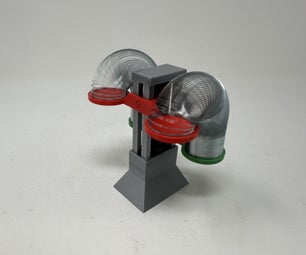Introduction: Cast Concrete With Fabric Texture
Make a panel of industrial concrete with a sensual surface taken from an existing or created textured material.
Step 1: Supplies + Equipment
Supplies:
Treated fabric or textured surface and plastic wrap to protect if so desired
Piece of .25" plexi as base at least 2" larger than your mold
Particle mask + gloves
Concrete mixture (I used Quickrete Anchoring Cement)
Scale or other measuring device
Plastic mixing container + strong utensil
Adjustable casting box mold + clamps
.25" grid hardware cloth 1"-1.5" smaller than final piece
Tin snips for cutting hardware cloth
Four .75" 10-24 screws + 8 nuts to match
Piece of .125" or .25" masonite for backing 1"-1.5" smaller than final piece (not shown)
Tiny amount of oil or acrylic paint (not shown)
Drill (hand or power) + drill bit larger than screws (not shown)
Braided picture hanging wire (not shown)
Step 2: Preparing the Base
Start with a fabric or texture of your choice (not thicker than .125” or the concrete will seep underneath). I created a furrowed surface by hand-manipulating satin as I fused it to a flat piece of muslin.
Set the fabric on top of the sheet of plexiglas. If you don’t want to get concrete on your fabric, protect it with a piece of saran wrap. Note: the saran wrap will result in a shiny surface. You can rough it up later on if desired.
Step 3: Preparing the Mold
In the supplies, I gave a link to the Adjustable Casting Box Mold. You can see in the pics that mine is a little simpler and works just as well. [I cut several 2" strips of .75" plywood from an old cabinet door and cut them to 16" lengths for the mold and 1" or 2" pieces for the clamp holds, which I simply nailed in.] Set up the mold to the size you want. Mine makes a 10” square. I use a triangle to make sure the corners are at right angles. I also put lines on my mold showing the depth I want to pour the concrete to. In this case I’m casting .5”.
Step 4: Preparing the Reinforcement
Cut a piece of .25” grid wire mesh, about 1”-1.5” smaller than your mold. This gives the concrete something to attach to and acts as a reinforcement.
To provide a means for hanging, I attach machine screws, holding them in place with nuts, into four spots on the mesh. I place them about 2” in from the corners.
Try to bend out any curves in the mesh so it is as flat as possible.
Step 5: Mixing the Concrete
Wear a particle mask and gloves. I always have my glasses on, but if you aren’t lucky enough to wear them, consider also wearing eye goggles (for the powder).
Measure the concrete. This requires some trials and note taking. The mixing ratio for the concrete I used (Quikrete Anchoring Cement) is 5 : 1, concrete to water. I used 4.16 lbs. of concrete with 13 oz. of water for .5” depth in a 10” square.
I use a food scale I found at the thrift store for measuring (and of course never use it for anything edible!). Place the measured concrete powder in a mixing container. With a stirring utensil at the ready (mine is a plastic rice paddle from the thrift store) dump in the water and stir vigorously until you get all powder mixed in and the lumps out. While it’s tempting to add more water, the thicker the mixture is, the stronger the concrete.
Step 6: Pouring the Concrete
Pour the concrete into your mold about half way, making sure it gets everywhere. Then insert the mesh piece with the screws posts facing up; continue to pour in the concrete to cover the mesh. It's best to work quickly as some concrete mixtures, like the one I used, can set within minutes. When the concrete is all in, adjust the screws in case they are not perpendicular. Ideally they should be at right angles to the concrete surface and all have the same amount exposed.
Let the concrete cure. To avoid cracking, you can cover the mold with a sheet of plastic. It can be handled in an hour or so, but it may take 2 or 3 days to fully set, during which time the color will change too.
Step 7: Attaching the Backing
Once the concrete has cured, release the mold. Label the top of the concrete (or orient it in some way). Put a little dab of oil or acrylic paint on the end of each screw. Take the piece of masonite for the backing and center it on the back of the concrete, resting on the screws so that the paint leaves a mark. Label the top of it also so you can reorient the parts later.
With pen or pencil make circles around the paint marks on the masonite and then wipe off the paint. Drill holes that will allow the screws to fit through. I used a .25” drill bit.
Reorient the masonite with the back of the concrete allowing the screws to come through the holes and hold it on with another set of nuts.
Step 8: Finishing
Cut a piece of braided picture hanging wire about 3" longer than the distance between the top two screws. Unscrew each slightly and slide the wire between the nut and the masonite, screwing the nut back down to hold the wire in place. Twist the loose ends of the wire into the remainder. Voilá, you may now hang your work of art.
You might consider coating the surface with an acrylic sealer. There are ones made specifically for concrete that absorb nicely. If anything looks too shiny, use a fine wire brush to scuff it up a bit.









